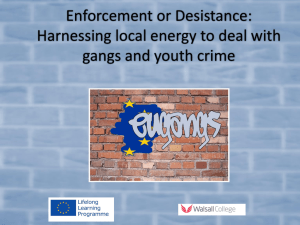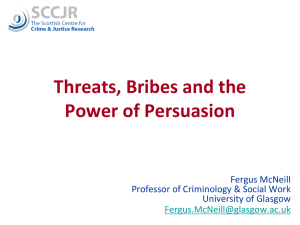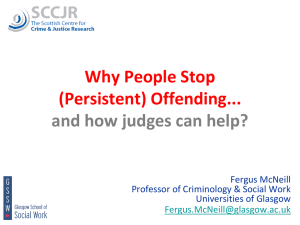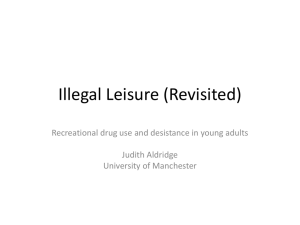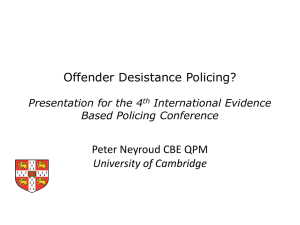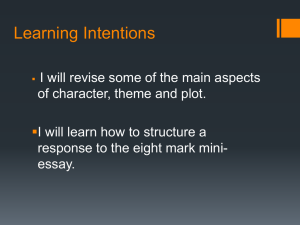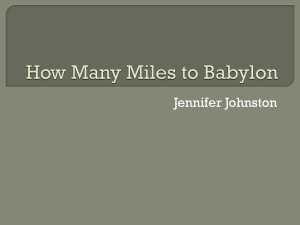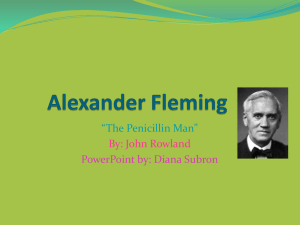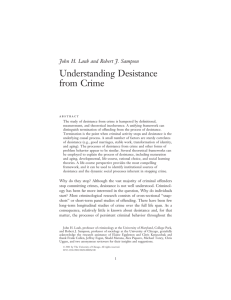Art, Science and Desistance
advertisement
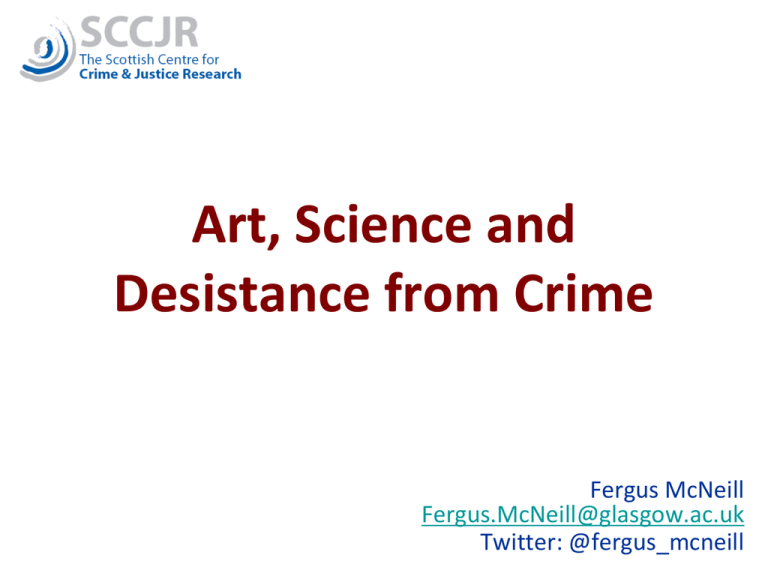
Art, Science and Desistance from Crime Fergus McNeill Fergus.McNeill@glasgow.ac.uk 1 Twitter: @fergus_mcneill The plan… • First a brief and selective review of the ‘science’ about the process of desistance • Then some evidence about the impact and potential of the arts in inspiring desistance • Finally, some speculations about the relationships between arts, science and desistance…. Why desistance matters • Studying desistance forces us away from static models of people as ‘offenders’, ‘criminals’ or ‘prisoners’ and encourages an understanding of change(s) in personal identities, behaviours, belonging • If we aim to reduce reoffending and to promote successful reintegration/re-entry, then desistance theory and research can and should inform the redesign of our institutions, cultures and practices • Caveat emptor: This is not a program, a product or a solution; it is a body of evidence in which policy, practice and community development should be embedded – A bit like the way in which educational approaches need to be embedded in an understanding of child development. Definitions • Persistence and desistance • Desistance as a process not an event • ‘Natural’ versus ‘assisted’ desistance (rehabilitation) • Primary and secondary desistance – Constraint-based, calculative, habitual and normative compliance – Secondary desistance and constructive, generative citizenship Age and Maturation Explaining desistance Narratives Identities Life Transitions, Social Bonds From Bottoms and Shapland (2011: 70) Some key lessons about desistance journeys • They are complex processes, not events, characterised by ambivalence and vacillation • The involve re-biography (at the time or post hoc) ; changing identities (narratives); more than learning new cognitive skills • Prompted by life events, depending on the meaning of those events for the offender; inherently subjective, hence individualised, sensitive to difference/diversity • Solicited or sustained by someone ‘believing in’ the offender (or prevented by someone giving up on the offender?)... Hope • An active process in which agency is discovered and exercised • Requires social capital (opportunities) as well as human capital (capacities/skills) –alters the context of (terrain for) the journey • Certified through ‘redemption’ or restoration (de-labelling); finding purpose in generative activities [constructive reparation ] Supporting desistance Social change Personal change Principles • Researchinformed • Realistic • Co-productive • Hope • Strengths • Agency • • • • Constraints Social capital Recognition Reintegration What role for the arts? This section is based on: • Anderson, K., Colvin, S., McNeill, F., Nellis, M., Overy, K., Sparks, R and Tett, L. (2011) Inspiring Change: Final Project Report of the Evaluation Team. Details online at: http://www.artsevidence.org.uk/evaluations/inspiringchange-final-project-report-evaluation-t/ • McNeill, F., Anderson, K., Colvin, S., Overy, K., Sparks, R. and Tett, L. (2011) ‘Kunstprojecten en What Works; een stimulans voor desistance?’ (Trans. ‘Inspiring Desistance? Arts projects and ‘what works?’) Justitiele verkenningen 37(5): 80-101: http://blogs.iriss.org.uk/discoveringdesistance/files/2011/09/ McNeill-et-al.-2011-Inspiring-Desistance.pdf Prisons, arts and desistance • Prisons are not promising contexts for desistance from crime insofar as they tend to – Delay maturation – Disrupt social bonds – Cement negative identities Age and Maturation Explaining desistance Narratives Identities Life Transitions, Social Bonds The arts in prisons • Key claims of recent research on the arts in prisons include: – – – – – – – Developing better relationships between prisoners Developing better relationships with prison staff Developing better relationships with their families Improving self-esteem and self-confidence Improving engagement with learning Developing communication and social skills Enabling people to work as part of a group – £££Reducing reoffending??? Steps towards change • Caveats – – – – Participants’ realism No long term follow-up Limited opportunity to ‘test’ progress No easy way to measure behavioural change • But – Qualitative data captures important steps towards secondary desistance – Coding: Maturation, Social Bonds, Identity Choices and chances INT: …Do you think that these projects are meaningful to have in prisons? LISA: Aye, they are meaningful. SHIRLEY: They help people find themselves, as well. You learn about yourself. LISA: Like people don't think they're good at things and then they realize that, aye, they are. SHIRLEY: They are talented. Or maybe they make bonds with people and it makes it easier for them, some of them. Do you know what I mean? INT: Yeah, definitely. So, I think it's those things, which could maybe contribute later to whether you reoffend, or not. LISA: Aye. (National Portrait Galleries, Greenock, post) Maturation ALEC: Oh, aye, every single one of us will have to make that decision of whether we go to the licensed grocers or whether we go get the bus straight home. Every single one of us is going to have to make that choice. Because every single one of us has been locked up for X amount of time. INT: Right. ALEC: And we all have X amount of things that we want to do. JOHN: I know. ALEC: And our family want us to come home. (Citizens Theatre, Barlinnie) Social Bonds: Family RAB: You got to remember. They’re out there sticking by us. Putting up with all this crap, know what I mean? And it’s the good things they should be involved in as well, in our life, you know? KENNY: When we are put in prison, it’s not just us that’s punished. It’s our families as well. RAB: Aye, everybody round about us. KENNY: So, when you’re doing something like this, it’s letting them see that you’re trying to better your ways, so to speak. You’re not just in here being a thug. (Traverse Theatre, Castle Huntly) ALEC: …It was almost like you're family were coming to visit you at the end of your shift at work. (Citizens Theatre, Barlinnie) Social Bonds: Networks ALEC: Also I thought it gave me the opportunity to get in touch with people outside as well. INT: Okay. ALEC: You know, the Citizens Theatre. So it gave me maybe some chance of work. Some chance of... INT: connection. ALEC: becoming integrated back into the community again without having to rely on negativity, you know? JOHN: Aye. ALEC: And doors getting closed, you know? It afforded me the opportunity for maybe some doors to get opened. (Citizens Theatre, Barlinnie) Identity (and performance) You don’t know how it’s going to go down and you’re in front of the governor and the deputy and what not. I thought it was a success because I got my message across. I enjoy what I do. Personally, I think I’m quite good at it and people agreed with me, you know what I mean? They thought it was good. (Scottish Ensemble, Polmont) The warden was there. All the social workers were there. There was other people there. And it all came together like a proper concert. Your family could come in. I thought it was fantastic. Very good. (Scottish Ensemble, Polmont) Identity (and relationship) ALEC: To get people to come into the prison and actually want to work with us, you know, is amazing. It makes you feel quite blessed, you know? To think that people come in here and they want to help you put on a performance. INT: Yeah. ALEC: That's amazing cause I think sometimes people think you're just a con. You're out of society. You're out of the mould. STEVE: And they didn't judge us, definitely. ALEC: They weren't judgmental in any fashion. INT: Yeah. ALEC: They asked us questions. They wanted our input. (Citizens Theatre, Barlinnie) Methodological challenges • Process and outcome, but what about when the outcome is to progress a long-term process? • Intermediate, ‘soft’, theory-based (identity) indicators versus ‘hard’ (behavioural) data • Cost effectiveness? Short, medium or longterm? • Secondary versus primary desistance – What matters versus what counts Singing a new song Is desistance itself art? • From often unpromising raw materials, in often unpromising circumstances, people find the inspiration and… – – – – Learn to sing a new song Author a new story Paint a new picture Sculpt a new shape • They dig the beauty out of the miry bog • They find a new foundation • If this is a (re)creative process, then we need to nurture (re)creativity Conclusions Principles Personal change Social change • Desistance (transformation) as art • The art (and science) of personal transformation BUT ALSO • The culture representation of transformation • Culturally transformative arts
